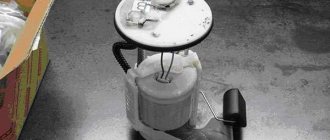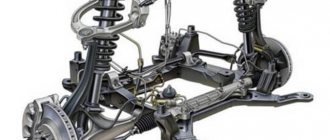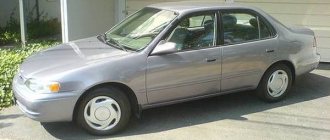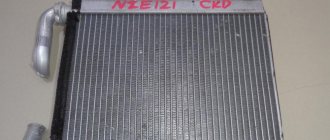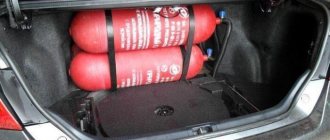Parktronic is a sensor system installed on cars to assist with parking and maneuvers. It informs the driver about an approaching obstacle with a sound signal and a light indicator.
To figure out what exactly went wrong in the entire system, you need to understand the principle of operation of the parking sensors. It works this way: sonars mounted in the bumper emit ultrasonic signals that are reflected by the obstacle. The signal is returned to the sensor, and from it is transmitted to the control unit. It calculates the distance from the difference between the time the signal was sent and returned.
Diagnostics of faults and replacement of parking sensors Toyota Camry 40
Parktronic is a sensor system installed on cars to assist with parking and maneuvers.
It informs the driver about an approaching obstacle with a sound signal and a light indicator. To figure out what exactly went wrong in the entire system, you need to understand the principle of operation of the parking sensors. It works this way: sonars mounted in the bumper emit ultrasonic signals that are reflected by the obstacle. The signal is returned to the sensor, and from it is transmitted to the control unit. It calculates the distance from the difference between the time the signal was sent and returned.
Basic faults
Malfunctions in the operation of the parking sensors definitely cause discomfort: if the driver is accustomed to relying on the sound signal of the safe parking system, parking using the “traditional” method becomes quite difficult. Parking sensors may either not work or display data incorrectly.
The causes of malfunctions may be the following:
- Wiring problem. Wires connect the control unit with several sensors. However, their fastening is not reliable enough everywhere - for example, it can be attached to a bumper with metallized tape. One big drawback is that the sensors are often not firmly attached. While they are shaking, remaining in their position, the data is inaccurate.
- Wiring may melt or break. To prevent this, you will have to periodically inspect the wires of the safe parking system.
- Error in the control unit. This parking safety system unit is installed separately from the ECU. Inside it there is a special subsystem that detects the presence of malfunctions and reports this to the driver. Not all modern systems are equipped with such a subsystem, but it is not so difficult to suspect improper operation of the sensors.
- Dirt on sensor receivers. Dirt and dust will obscure the sensor's view. You can avoid this by regular washing. But if there is too much dirt and dust, the bumper will have to be disassembled and washed separately. Even worse, if a stone hits it at high speed, the sensor will break due to the high impact force.
- Dirt in the control unit. Circuits and boards don't like being covered in dirt - anything can lead to a short circuit. The probability of this event is extremely low, because the control unit is quite seriously closed from external sources of dust and dirt.
This is interesting: Hawal N9 configurations: technical specifications
Features of parking sensors on Camry 40
The main difference between the original sensors installed from the factory is the accuracy of readings and long service life. Toyota Camry in the 40th body in various trim levels is equipped with a parking system with a different number of sensors:
- with 2 sensors located in the rear bumper;
- with 4 sensors installed in pairs in the front and rear bumpers;
- with 6 sensors, 2 of which are mounted in the front bumper, and 4 are located on the sides and in the center of the rear bumper.
It is important to keep in mind that the sensitivity of the front and side sensors is different from the rear, so they are not interchangeable. The rear ones react to obstacles located at a distance of less than 2 meters, while the front ones signal already at a 5-meter distance. When the vehicle speed exceeds 5 mph, the entire system is automatically switched off.
Other additions from this review
Code 31 - 3 flashes, pause, 1 flash MAP absolute pressure sensor in the intake manifold Open or short circuit in the electrical circuit of the MAP sensor. Code 32 - 3 flashes, pause, 2 flashes. Air flow meter V6 engine.
Air flow meter or air flow meter electrical circuit. Code 41 - 4 flashes, pause, 1 flash Throttle position sensor Open or short circuit in the electrical circuit of the throttle position sensor. Throttle position sensor or throttle position sensor circuit.
Parking sensors do not work on Camry 40: signs and diagnostics
When turned on, a working parking sensor emits a single beep, notifying the driver that the sensors are activated. If, after turning on the ignition or after pressing the system activation button, the parking sensors do not work - they behave in an unusual way: they are silent, beep continuously or make sounds of an unusual tone, then it is out of order.
The easiest way to find out the cause of the breakdown and identify the faulty element is computer diagnostics. You can contact an official service or service station, or you can carry out diagnostics yourself: for this you will need a scanner that reads errors and a manual with decoding of the codes.
There are other ways to determine the breakdown. Diagnostics begins with identifying the element that has failed. This could be any of the parking sensor elements:
- sensors;
- Control block;
- display panel.
If, when the ignition is turned on, the parking sensors do not “show signs of life” and do not start after pressing the button, then most likely the problem lies in a blown fuse. Replacing it is not difficult - it is located in the interior on the dashboard, which can be found under the plastic trim on the left below the steering wheel. If replacing the fuse does not solve the issue, then the problem must be looked for further in the wiring or in the control unit itself.
If the parking sensor emits multiple beeps when turned on, it means one or more sensors are broken. The Toyota Camry, unlike other cars in this class, has a self-diagnosis function for parking sensors. If, when you turn on the system before shifting into reverse gear, after a single signal you hear:
- double signal - the front left or rear right sensors are faulty;
- triple signal - the breakdown lies in the front right or rear left pair;
- a quadruple signal indicates the failure of both sensors in one of the diagonals or all four sensors at once.
The rear center sensors only turn on after shifting into reverse gear and their signal sounds different.
Design features and types
Regardless of whether you use standard or self-installed parking sensors, it may fail. Moreover, we will consider a situation where everything was fine, but suddenly the radar stopped working.
Electromagnetic and ultrasonic types of parking sensors are used on sale and as standard equipment for cars. They have slightly different principles of operation, since they are based on the use of different sensors. If we talk about Russia and the CIS countries, then ultrasonic systems are more in demand here. They are divided into wireless and wired. This issue should be dealt with separately if you plan to install a radar yourself or through a car service that was not provided from the factory.
The design of ultrasonic systems uses ultrasonic sensors and a control unit. In fact, the block is the brain of the equipment.
As for the electromagnetic analogue, that is, the role of the sensor is taken on by a metallized tape. It is fixed to the inside of the bumper. Using the tape, an electromagnetic field is generated. When an object or obstacle hits it, the sensor transmits a signal to the control unit, which informs the driver of the danger.
The advantage is on the side of the electromagnetic option. This is due to the fact that here, unlike its ultrasonic competitor, there is no such thing as blind or dead zones. Such tape-based systems provide better control over strictly defined distances and areas. That is, they are characterized by a more efficient and accurate reaction to what is happening in front and behind the car. But there is no limit to perfection. Increasingly, the car receives not only a standard radar, but also an additional camera. This allows you to combine graphics, sound signals and video images.
Objectively, the benefits of rear parking sensors are much greater than those of the front ones. But the latter also greatly helps the driver to maneuver in certain situations.
Staff
Some built Camry 40 cars use parking sensors with ultrasonic sensors mounted in the front or rear bumpers. Sensors emit signals that are reflected from an obstacle and received by a sensitive element built into the sensor. The sensors are connected by wiring harnesses to a separate control unit, which calculates the distance to the obstacle (based on the time difference between the signal and the reception of the reflected wave).
A special display is installed on the instrument panel to display information. A signal buzzer is mounted in the design of the unit; the frequency and volume of the speaker sound increases as the vehicle approaches the obstacle. There is no adjustment (picture brightness or sound volume level) for the panel.
The device is activated after engaging reverse gear or using a separate button. To turn on the equipment on the early V40, a non-backlit button is used, which can be replaced with a similar product from the subsequent Camry 50 model (catalog number 84490-33030). The built-in green backlight diode matches the background lighting of the car interior, allowing you to find the key in the dark. A similar button was found on some V40s released after restyling.
The plant produced cars with 3 parking sensor schemes:
- with 2 sensors located on the rear bumper;
- with 2 additional sensors installed on the corners of the front bumper;
- version with 2 front and 4 rear sensors.
Toyota Camry sensor housings are made of impact-resistant plastic, coated with paint in the body color at the factory. Devices located on the side of the bumper are highly sensitive. It is prohibited to install side sensors on the rear surface of the bumper and vice versa, since the elements will not ensure accurate distance measurement. The control unit is connected to a speed sensor; when the car reaches a speed of 5 km/h, the system automatically turns off.
The control unit supports the diagnostic function of installed sensors. A double signal from the buzzer when the gear selector is in the park (P) or neutral (N) positions indicates a malfunction of the front left or rear right sensor. With a triple signal, a breakdown is detected on the front right side of the bumper or on the left rear. A quadruple signal is given when sensors break down diagonally or when all existing sensors fail.
Analogs
Original components are produced by Denso, which supplies parts to the aftermarket in original Toyota packaging or under its own brand. Sensors similar in configuration and operating parameters are produced by Chinese companies.
The products have a reduced cost; the length of the patch cords and the configuration of the connecting blocks are identical to the original design.
If the control unit breaks down (a rare malfunction) located under the right trim of the luggage compartment, the unit must be replaced with an original product.
How to install and connect
The owner of a Camry car can independently install parking sensors by following the algorithm of actions;
- Mark the surface of the bumper for installing sensors.
- Carefully drill through the plastic with a special drill; the sensor should not hang out in the made channel. The part is held by special protrusions made on the body.
- Install a signal board in the cabin; the unit is located on the instrument panel or on the ceiling panel. The power is connected to the vehicle’s on-board network, a separate cord is led to the reverse gear signal sensor in the gearbox.
- Lay the patch cables by passing the cords from the cavity of the bumper into the body through the technological holes. The cables to the instrument panel are laid under the plastic trim of the sills and body pillars.
When replacing sensors, dismantling the bumper is not required; the products are removed with a special plastic spatula, which does not damage the car’s paintwork. The part lifted with a spatula is pulled out of the seat with force; there are metal plates on the body that are used to speed up the removal procedure. The patch cord connector is disconnected by hand (there is a plastic latch on the unit).
When installing a new product, you must connect the pads and install the sensor into the bumper until it clicks. The plug is equipped with a special guide pin that prevents the halves from being connected in the wrong position. An identification label with the manufacturer's number and logo, as well as a double arrow, is glued to the sides of the part. During installation, the arrows should be directed up and down. If installed incorrectly, the sensor incorrectly measures the distance and sends a constant obstacle detection signal to the control unit, causing the buzzer to sound.
When and how does replacement occur?
Often, parking radars begin to show incorrect values precisely because the sensor is damaged. The reasons for such a breakdown can be very different. This includes incorrect installation of the parking sensors themselves, poor quality of their assembly, contact of sensor wiring with water, and much more. It is impossible to predict which of them will become critical for your car. Therefore, you should send your car for diagnostics at the first suspicion of a malfunction.
As for the replacement process, it is carried out in the following sequence:
- You bring the car to Ochakovo and hand it over to our specialists.
- After conducting diagnostics, the technicians notify you of the final cost of the work.
- The working surface is cleaned of dirt, the sensor wiring is disconnected from the rig PC.
- Next, the problematic sensor is dismantled, and the vehicle owner decides which sensor to install as a replacement. After installation, the product is synchronized with the on-board PC.
- All necessary tests and control checks are carried out.
- Work process
- repair 1
- repair 2
- Repair 3
- repair 4
- repair 5
Parking sensors for Toyota Camry
Most cars produced today, especially executive and business class ones, are equipped with advanced security systems and numerous electronic assistants. These also include parking sensors - parking sensors, thanks to which you can easily park even in the most cramped conditions without damaging the car's bumper.
Parking sensors for Toyota Camry
Parking sensors on the Toyota Camry v30 , as well as on models in subsequent bodies, are highly reliable and durable, but they can also fail. This mainly happens under the influence of external factors.
How parking radars work
Parktronic is a set of equipment that allows you to identify obstacles located in the driver’s blind spot. With their help, a beginner can park safely even in cramped conditions, because not every car owner accurately feels the dimensions of his car.
Parking sensors on a Toyota Camry in the 40 body, as well as on most models, consists of several components:
- ultrasonic sonars located in the front and rear bumpers of the car;
- data processing unit;
- display panels with sound notification.
Parking sensors work as follows:
- The sonars located in the bumper generate ultrasonic frequencies.
- When the signals hit obstacles and are reflected from them, they return and reach the sensor.
- The control unit, taking as a basis the time difference between the transmitted and returned signal, calculates the distance.
- In the cabin, an indication and sound alarm are activated, which increases in intensity as the distance decreases.
Operation of parking radars on a Toyota Camry
Timely notification of objects located in the vehicle's movement zone allows you to stop and thereby avoid a collision.
A distinctive feature of parking systems installed on cars of this brand is the high accuracy of readings, which is not available for most budget versions, of which there are plenty on the market. In addition, Toyota sonars are highly reliable - the main reason for their malfunction is only mechanical damage.
How to replace or install a parking sensor
If the sonar fails, the functionality of the entire system can be restored only by replacing the faulty sensor. Depending on the version of the control unit, even with several faulty sensors, the parking system may work, but its information content will be significantly reduced. This may lead to the car colliding with an obstacle when parking.
Since the cost of the bumper is significantly higher than the cost of the sensor, the best option would be to timely replace the sonar if it fails. To quickly replace parking sensors on a Toyota Camry, first remove the faulty unit.
You can find it in two ways:
- Connect to the car with an error scanner and look at the computer fault codes. The car's operating instructions contain explanations of error codes. In addition, many car scanners automatically decipher errors.
- If the car is equipped with a standard BC, then the fault will automatically appear on its display. However, in some cases, the capabilities of the built-in on-board computer are not enough to accurately diagnose the error.
Replacing parking sensors on Toyota Camry 40 and 50 is carried out in the following order:
- The bumper mounts are dismantled, then the bumper is removed from the car body.
- After this, access to the mountings of the parking sensor itself opens.
- The connectors from the faulty sensor are disconnected, then a new sonar is connected to them.
- The functionality of the new sensor is checked. To do this, you can simply turn on the parking sensors and bring your palm to the sensor - a sound alert should sound.
- Only after checking the functionality of the new sonar can it be installed in place and the bumper secured.
are changed in a similar way . To replace the front sonars, it is not necessary to remove the bumper - you can simply remove the plastic wheel arches installed in the front wheel arches.
Layout of parking sensors on Toyota Camry
In the event of damage to the electrical wiring, the scope of work increases significantly - after all, the best option is to replace all wiring, from the control unit to the sensor. And for this it is necessary to disassemble literally half of the interior.
Therefore, it is better to entrust the work of restoring the functionality of the parking system to specialists. Especially if the car is under warranty.
It is also worth considering the quality of the installed spare parts; the best choice would be to install the original.
Features of parking sensors on Camry
Parking sensors on Toyota Camry v40 and v50, depending on the vehicle configuration, are installed in various configurations.
- With two parking sensors located in the rear bumper.
- With four parking sensors located in pairs in both bumpers.
- With 6 sensors, 4 of which are located in the rear bumper.
Parking sensors for Toyota Camry v40 with four sensors located in the rear bumper.
The sensitivity of each sonar is different. For example, the front ultrasonic sensors on the Camry can detect an obstacle at a distance of 5 meters, while the rear sonars operate from a distance of 1.5-2 meters. But this is quite enough to prevent hitting an obstacle.
When an obstacle is detected, the electronic unit activates a sound alert, which intensifies (the squeaking becomes louder and more frequent) in proportion to the decreasing distance. But it is important to consider that the parking sensor on a Toyota Camry does not work as effectively if it is dirty, and therefore it is important to keep the car clean.
If the sonar fails, the cost of replacing it remains at a fairly high level: the original rear parking sensors on the Toyota Camry v40 will cost car owners about 10 thousand rubles for one sensor. Analogs will cost much less (from 1.5 to 5 thousand rubles), but their performance is very difficult to guarantee. In addition, it is worth considering that the level of sensitivity of non-original sensors can be greatly underestimated, and this will make the parking sensors ineffective.
summary of the entire topic for inclusion in the header
I got confused about making notes. I suggest the moderator put it in the header
There is an opinion that the parking sensor system on the Camry V40, to put it mildly, has disadvantages:
1. Standard parking sensors eventually fail anyway (about 5 years) - so there is little point in looking for sensors at disassembly sites and it makes sense to replace or repair all sensors at once, and not just the ones that have failed. 2. There is not enough visualization on the display (that’s why some people prefer to replace it with something Chinese) 3. Original sensors are unreasonably expensive (from $50 on Aliexpress to $100 on Exist) 4. Angle sensors are easily removed (therefore they are often stolen).
There is an opinion that you shouldn’t worry, but it’s better to just install a rear view camera (the price is about $100) and forget about the parking sensor button. But those who want everything to work as it should also deserve respect.
Popular symptoms of sensor failure:
- Visual - paint peeling/bubbling, corrosion, chips.
- strange glitches that appear depending on the climate in the garage, the directness of the body workers' hands, the difference in humidity and temperature of the outside air and exhaust gases, the serviceability of the overrunning clutch and generator diodes, the quality of the fuel at that gas station, yesterday's and today's weather, the phase of the moon.
- Sensors can be sensitive to incoming air flow, insects, exhaust gas flow, grass, dirt, moisture and ice, gravel or Kamaz truck flying into their forehead.
Design Features:
- consists of an electronic microassembly and a piezoceramic sensor.
- angular sensors - barrel - one housing with microassembly and ultrasonic sensor.
- the central ones seem to be L-shaped, and can be dismountable (the sensor is easily separated) from the microassembly body.
- “microassembly” is not suitable for repair in a workshop due to its delicacy and miniature size.
- around the microassembly there is a white compound made of soft rubber (it can be seen where the wires exit), around the sensor there is a sleeve of denser rubber or silicone almost in the color of the case (it is visible from the outside).
- You should not try to disassemble the sensor (except for pulling out the sensor), there is nothing interesting inside, but only a microassembly that does not break on its own.
- The sensor diameter of the angle sensors is just over 14 mm.
- The sensor depth of the corner sensors is just over 9 mm.
- the exact mounting diameter of the angle sensor holes is 22 mm
- The shape of the sensor is a cylinder with two notches.
- the rubber coupling in which the sensor is installed must be intact and undamaged and must not be painted, otherwise the operation of the sensor will be disrupted.
- the sensor has a non-axisymmetric “directional pattern” - i.e. It is important that the horizon is not blocked. There is an opinion that the sensor is normally installed with springs up and down. Also on the paper sticker with the inscription Denso there are arrows that should be directed vertically.
- If placed incorrectly (with springs left and right), the parking sensor will actually turn into a ground clearance sensor and will react to the proximity of the road surface.
- Angle sensors are relatively easy to remove (using a credit card and a flathead screwdriver), but there is always a risk of damaging the decor. It is necessary to pry from the top and bottom, because there are springs.
- I assume
that the central rear sensors cannot be removed without removing the bumper (however, the bumper itself is not difficult to remove https://camry-club.ru/forum/showthrea.l=1#post849939). - I suppose
let the electronics engineers confirm that it is not necessary to observe the polarity on the sensor itself, because... This is not a semiconductor, but a piezoelectric element. - I assume
that the geometry of the sensor greatly influences the measurement characteristics (sound propagation speed, resonances), i.e. the dimensions “a little more than 14 mm” and “a little more than 9 mm” are most likely related to the sound wavelength in ceramics at a frequency of 40 kHz, so it hardly makes sense to grind the sensor heavily (to remove shells from corrosion), but if there is nothing to lose , then you can try. - I assume
that all four corner sensors are interchangeable, and the sensors are the same on all 6 sensors.
How to turn on parking sensors on a new Camry
The new, 7th generation Camry is distinguished by high technology and convenience. But in the changed interior, many car owners literally get lost in the numerous buttons and switches, and sometimes don’t know how to turn on the parking system.
The parking sensor button on the Toyota Camry 50 is located on the left side of the steering column. There are 3 buttons in this block, and the one responsible for the parking system is located to the right of the others. The parking system is activated by pressing one button, and all sensors installed in the system become active at once.
If, when you press the sonar button on a Toyota Camry, the parking sensors constantly beep , this indicates the failure of one or more sonars.
Parktronic activation button for Toyota Camry v50
You can check their performance using computer diagnostics - it allows you to identify a malfunction in a few minutes.
We need a diagram of the parking sensor system for a 2012 Toyota Camry V50.
#1 syetra
- Users
- 74 messages
- City: Koryazhma
- Gender: Man
The rear sensors do not work, I changed them in turn with the front ones, the rear still does not work, error c1aed - the rear circuit is faulty. The sensors are connected in series. We need a diagram, incl. and the brains of the parking sensor.
- Top
- Nickname or quote
#2 kolyan750
- City: Neftekamsk
- Gender: Man
Post edited by kolyan750: 27 October 2015 — 09:40
- syetra likes this
- Top
- Nickname or quote
#3 syetra
- City: Koryazhma
- Gender: Man
Thank you very much Nikolay, this is what I was looking for.
- Top
- Nickname or quote
#4 syetra
- City: Koryazhma
- Gender: Man
Thank you, I did everything, I spent half a day before and didn’t find the fault, I rang everything. Today I removed the entire braid and disassembled the connectors. The pins in the rear far left sensor are rotten. I soldered it directly and it worked. Thank you.
- Top
- Nickname or quote
- APC ADACT
- → Auto electrics and auto electronics
- → General
- Forum Rules
ARS ADACT develops firmware for chip tuning of gasoline and diesel engines. Ready-made calibrations for any task are available in the official store: more than 60 brands and 300 models, for LPG, with the transition to other Euro standards and preservation of factory ones. If there is no ready-made firmware, you can order individual calibration for any task.
ADACT firmware can only be purchased in the store on the official website. Their distribution is protected using a SenseLock key and a user activity rating system. Any other sites offering ADACT firmware present their own unverified work as calibrations from our company.
Causes of damage to parking sensors
Quite often, parking sensors do not work on Toyota Camry 40 due to mechanical damage. This is due to their location, which makes the sensors very vulnerable in the event of collisions with obstacles. Moreover, the situation with cars of this brand in other bodies is completely similar.
In addition, the following malfunctions occur in the system:
- failure of sonars due to a sudden change in temperature;
- malfunction of electrical equipment, as a result of which individual elements of the system fail;
- electronic control unit software failure;
- damage to the wiring connecting the sensors to the BC.
Often the cause of the malfunction lies in a blown fuse. Changing it is not difficult - the parking sensor fuse on the Toyota Camry 50 is located in the interior panel. To access it, you need to remove the plastic trim located below and to the left of the steering wheel - underneath it hides a group of fuses responsible for the operation of almost all car systems.
Panel with parking sensor fuses for Toyota Camry 50
If one sensor fails, the parking system does not stop working, but when turned on, an audible alarm will be activated. And if on a Toyota Camry the parking sensors beep after turning them on, then this is the first sign of the sonars failing . The malfunction can only be eliminated by replacing the faulty sensor.
To restore the functionality of the parking sensors after replacement, in some cases it is necessary to remove the terminals from the battery for a few minutes.
Original parking sensors CAMRY B40 B50
If, when you turn on the system before shifting into reverse gear, after a single beep: The rear center sensors turn on only after shifting into reverse gear, and their beep sounds. Replacing parking sensors on a Toyota Camry 40 Having determined the cause of the malfunction, before starting repairs you need new spare parts.
A quadruple signal is given when sensors break down diagonally or when all existing sensors fail.
Analogues Original components are produced by Denso, which supplies parts to the aftermarket in original Toyota packaging or under its own brand. Sensors similar to the Toyota Camry's standard parking sensors and operating parameters are produced by Chinese companies. The products have a reduced cost; the length of the patch cords and the configuration of the connecting blocks are identical to the original design.
If the control unit breaks down, a rare malfunction located under the right trim of the luggage compartment, the unit must be replaced with an original product. How to install and connect The owner of a Camry car can independently install parking sensors by following the algorithm of actions; Mark the surface of the bumper for installing sensors.
Carefully drill through the plastic with a special drill; the sensor should not hang out in the made channel. The part is held by special protrusions made on the body.
Install a signal board in the cabin; the unit is located on the instrument panel or on the ceiling panel. The power is connected to the vehicle’s on-board network, a separate cord is led to the reverse gear signal sensor in the gearbox.
This is due to their location, which makes the sensors very vulnerable in the event of collisions with obstacles. Moreover, the situation with cars of this brand in other bodies is completely similar.
In addition, the following malfunctions in the system occur: Often the cause of the malfunction lies in a blown fuse.
Installation of parking sensors on Toyota Camry V40 (50)
Changing it is not difficult - the parking sensor fuse on the Toyota Camry 50 is located in the interior panel. To access it, you need to remove the plastic cover located below and to the left of the Toyota Camry steering wheel. Under it lies a group of fuses responsible for the operation of almost all car systems. Panel with parking sensor fuses for Toyota Camry standard parking sensors Camry 50 If one sensor fails, the parking system does not stop working, but when turned on, the sound alarm will be activated.
And if the parking sensors on a Toyota Camry beep after turning them on, this is the first sign of the sonars failing. The malfunction can only be eliminated by replacing the faulty sensor. To restore the functionality of the parking sensors after replacement, in some cases it is necessary to remove the terminals from the battery for a few minutes.
How to replace or install a parking sensor If the sonar fails, the functionality of the entire system can only be restored by replacing the faulty sensor.
Depending on the version of the control unit, even with several faulty sensors, the parking system may work, but at the same time its information content will decrease. This may lead to the car colliding with an obstacle when parking. Since the cost of the bumper is significantly higher than the cost of the sensor, the best option would be to timely replace the sonar if it fails.
To quickly replace parking sensors on a Toyota Camry, first remove the faulty unit. You can find it in two ways: Connect to the car with an error scanner and look at the Toyota Camry codes for the standard parking sensors of the computer.
So, in the near future I will go to select paint: The sensor I ordered has an oem number: And the standard parking sensors are suitable for the following Toyota Camrys, if you believe the data provided by the seller: But it was experimentally discovered that they are also suitable for pre-restyling Camrys in the XV40 body, that is for those cars that were produced before the year.
The Restyle has already perfect sensors. I hope this information is useful to someone. On this. Thank you for your attention and your time.
